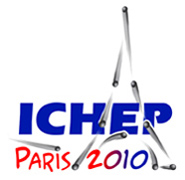Speaker
Daniel Traynor
(Queen Mary, Univ. of London)
Description
Transverse Momentum of Charged Particles at low Q^2 at HERA
The electron-proton collider HERA allows deep-inelastic scattering (DIS) at very small Bjorken-x of about 10^-5. At such small x new parton dynamics beyond DGLAP are expected to become important. Charged particle spectra are measured in DIS (Q^2 > 5 GeV^2), in different regions of pseudorapidity, using the increased statistics of HERA-2. The measurements are compared to simulations based on different Monte Carlo generators. It is shown that the region of small transverse momenta is primarily sensitive to hadronisation, whereas the region of large transverse momenta is mainly driven by perturbative parton radiation. The observed hardness of the transverse momentum spectra, when compared to different model predictions, can be interpreted as supporting the idea of parton dynamics beyond DGLAP.
Scaled momentum distributions of charged particles in dijet photoproduction at HERA
The scaled momentum distributions of charged particles in jets have been measured for dijet photoproduction with the ZEUS detector at HERA using an integrated luminosity of 359 pb-1. The distributions are compared to predictions based on perturbative QCD carried out in the framework of the modified leading-logarithmic approximation (MLLA) and assuming local parton-hadron duality (LPHD). The universal MLLA scale, Lambda_eff, and the LPHD parameter, kappa^ch, are extracted.
Scaled Momentum Spectra in deep inelastic Scattering at HERA
Charged particle production has been studied in neutral current deep inelastic ep scattering with the ZEUS detector at HERA using an integrated luminosity of 0.44 fb-1. Distributions of scaled momenta in the Breit frame are presented for particles in the current fragmentation region. The evolution of these spectra with the photon virtuality, Q2, is described in the kinematic region 10 < Q2 < 41000 GeV2. Next-to-leading-order and modified leading-log- approximation QCD calculations as well as predictions from Monte Carlo models are compared to the data. The results are also compared to e+e- annihilation data. The dependences of the pseudorapidity distribution of the particles on Q2 and on the energy in the p system, W, are presented and interpreted in the context of the hypothesis of limiting fragmentation.




